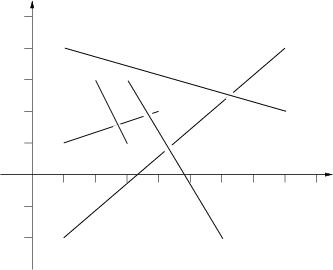http://poj.org/problem?id=2653
我很好奇为什么这样$O(n^2)$的暴力能过....
虽然说这是加了链表优化的,但是最坏不也是$O(n^2)$吗。。。(只能说数据太弱...)
然后本题裸的判线段相交和点在直线上...(看了网上的标程,不判端点的情况都能过我也是醉了...)
#include <cstdio>
#include <cstring>
#include <cmath>
#include <string>
#include <iostream>
#include <algorithm>
#include <queue>
#include <set>
#include <map>
using namespace std;
typedef long long ll;
#define pii pair<int, int>
#define mkpii make_pair<int, int>
#define pdi pair<double, int>
#define mkpdi make_pair<double, int>
#define pli pair<ll, int>
#define mkpli make_pair<ll, int>
#define rep(i, n) for(int i=0; i<(n); ++i)
#define for1(i,a,n) for(int i=(a);i<=(n);++i)
#define for2(i,a,n) for(int i=(a);i<(n);++i)
#define for3(i,a,n) for(int i=(a);i>=(n);--i)
#define for4(i,a,n) for(int i=(a);i>(n);--i)
#define CC(i,a) memset(i,a,sizeof(i))
#define read(a) a=getint()
#define print(a) printf("%d", a)
#define dbg(x) cout << (#x) << " = " << (x) << endl
#define error(x) (!(x)?puts("error"):0)
#define printarr2(a, b, c) for1(_, 1, b) { for1(__, 1, c) cout << a[_][__]; cout << endl; }
#define printarr1(a, b) for1(_, 1, b) cout << a[_] << ' '; cout << endl
inline const int getint() { int r=0, k=1; char c=getchar(); for(; c<'0'||c>'9'; c=getchar()) if(c=='-') k=-1; for(; c>='0'&&c<='9'; c=getchar()) r=r*10+c-'0'; return k*r; }
inline const int max(const int &a, const int &b) { return a>b?a:b; }
inline const int min(const int &a, const int &b) { return a<b?a:b; }
const double eps=1e-6;
int dcmp(double x) { return abs(x)<eps?0:(x<0?-1:1); }
struct Point { double x, y; Point(double _x=0, double _y=0) : x(_x), y(_y) {} };
typedef Point Vector;
Vector operator- (Point &a, Point &b) { return Vector(a.x-b.x, a.y-b.y); }
bool operator== (Point &a, Point &b) { return dcmp(a.x-b.x)==0 && dcmp(a.y-b.y)==0; }
double Cross(Vector a, Vector b) { return a.x*b.y-b.x*a.y; }
double Dot(Vector a, Vector b) { return a.x*b.x+a.y*b.y; }
int SSjiao(Point p1, Point p2, Point q1, Point q2) {
return (dcmp(Cross(p1-q1, q2-q1))^dcmp(Cross(p2-q1, q2-q1)))==-2 &&
(dcmp(Cross(q1-p1, p2-p1))^dcmp(Cross(q2-p1, p2-p1)))==-2;
}
int onSegment(Point a, Point b, Point c) {
if(a==b || a==c) return -1;
if(dcmp(Cross(a-b, c-b))==0 && dcmp(Dot(b-a, c-a))==-1) return 1;
return 0;
}
const int N=100015;
int nxt[N], ans[N];
Point a[N][2];
bool check(int now, int goal) {
if(onSegment(a[now][0], a[goal][0], a[goal][1]) ||
onSegment(a[now][1], a[goal][0], a[goal][1]) ||
onSegment(a[goal][0], a[now][0], a[now][1]) ||
onSegment(a[goal][1], a[now][0], a[now][1]) ) return 1;
if(SSjiao(a[now][0], a[now][1], a[goal][0], a[goal][1])) return 1;
return 0;
}
void del(int f, int now) { nxt[f]=nxt[now]; }
void work(int goal) {
int now=nxt[0], fa=0;
while(now!=goal) {
if(check(now, goal)) del(fa, now);
else fa=now;
now=nxt[now];
}
}
int main() {
int n;
while(read(n), n) {
nxt[0]=1;
for1(i, 1, n) nxt[i]=i+1;
for1(i, 1, n) {
rep(k, 2) scanf("%lf%lf", &a[i][k].x, &a[i][k].y);
work(i);
}
printf("Top sticks: ");
int now=0, cnt=0;
while(nxt[now]!=n+1) {
ans[++cnt]=nxt[now];
now=nxt[now];
}
for1(i, 1, cnt-1) printf("%d, ", ans[i]); printf("%d.
", ans[cnt]);
}
return 0;
}
|
Description Stan has n sticks of various length. He throws them one at a time on the floor in a random way. After finishing throwing, Stan tries to find the top sticks, that is these sticks such that there is no stick on top of them. Stan has noticed that the last thrown stick is always on top but he wants to know all the sticks that are on top. Stan sticks are very, very thin such that their thickness can be neglected.
Input Input consists of a number of cases. The data for each case start with 1 <= n <= 100000, the number of sticks for this case. The following n lines contain four numbers each, these numbers are the planar coordinates of the endpoints of one stick. The sticks are listed in the order in which Stan has thrown them. You may assume that there are no more than 1000 top sticks. The input is ended by the case with n=0. This case should not be processed.
Output For each input case, print one line of output listing the top sticks in the format given in the sample. The top sticks should be listed in order in which they were thrown.
The picture to the right below illustrates the first case from input.  Sample Input 5 1 1 4 2 2 3 3 1 1 -2.0 8 4 1 4 8 2 3 3 6 -2.0 3 0 0 1 1 1 0 2 1 2 0 3 1 0 Sample Output Top sticks: 2, 4, 5. Top sticks: 1, 2, 3. Hint Huge input,scanf is recommended.
Source |